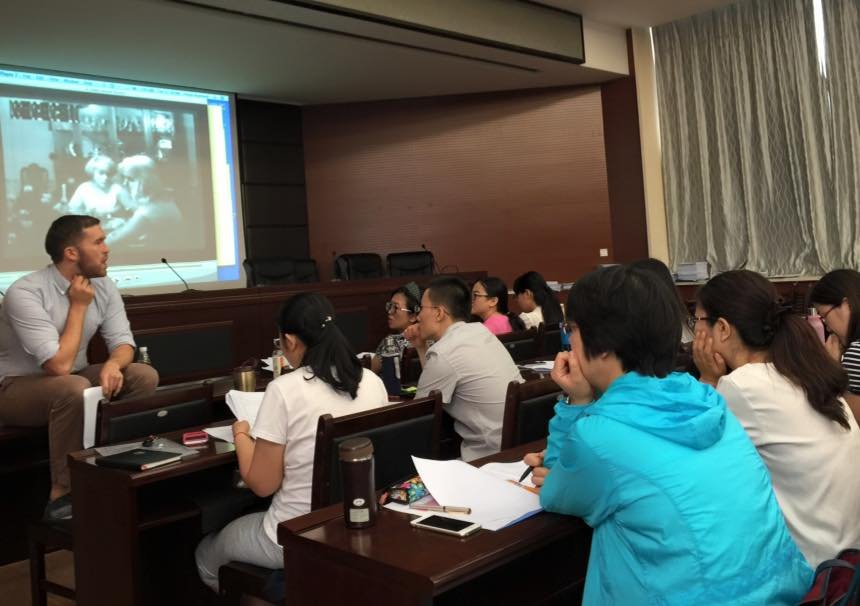TEACHING
Chase in his office on campus
(note: mug does not contain actual students’ tears)
University of Colorado, Boulder campus
At the University of Colorado, Boulder, I teach coursework on different aspects of language in society, including methods courses in Conversation Analysis & Interactional Linguistics. I also supervise folks working on their own research projects and independent studies. I welcome both undergraduate and graduate students, as well as postdocs and scholars interested in visiting CU-Boulder, to get in touch with me if they’re interested in supervision.
Information about the academic programs we offer in the Department of Linguistics can be found here for undergraduates (BA), and here for graduates (MA/PhD). Graduate students: Note that coursework with me counts toward the graduate certificate in CLASP (Culture, Language, and Social Practice).
Regularly taught courses
LING 1000: Language in U.S. Society (undergrad)
LING 3550/6300: Talk at Work - Language Use in Institutional Contexts (undergrad & grad)
LING 3700/5700 A & B: Conversation Analysis & Interactional Linguistics (undergrad & grad)
LING 6300: Research Design and Output (grad)
LING 7800: Bilingualism in Context (Ph.D. Seminar)
Variable topics courses
LING 3800/6800: Language Discrimination in Social Interaction (undergrad & grad)
LING 3800/6800: Human-Robot Interaction (undergrad & grad)
Prior to 2019, I regularly offered SPAN 4215: Spanish in the United States (undergrad, taught in Spanish)
For information on my teaching outside of CU-Boulder, click here.
TEACHING PHILOSOPHY
Given that we live in an age in which new information is just a few cellphone clicks away, the classroom has to provide something that students can’t get faster (and cheaper!) elsewhere. Why should Jane sign up for a ‘Research Methods’ course that meets three days a week…at 8:00AM…when she could just check out and read a textbook from the library? Why should James take my advanced ‘Language in U.S. Society’ course when he could find a quite a bit of content on-line through a Google Book preview, or a few free PDF downloads? The classroom must offer students something more.
On the floor with data during a methods training workshop at Shanxi University, China (2018), and giving a lecture at Loughborough University, UK (2018).
What that “more” is, exactly, naturally varies depending on the topic of the specific course in question; but regardless of the course or level, taking advantage of the forum setting of the classroom is crucial. Whether it is an introduction to the discipline, a capstone course for a student’s major, or an advanced graduate seminar, debate, discussion, and the hands-on application of knowledge are key. This is precisely the process through which students link course-specific content to other arenas, both substantively as well as methodologically. This is how students learn to think ‘outside of the box’ and move beyond a simple regurgitation of the five points covered in last week’s lecture. Instead, can they take those five points and apply them in a novel context, or to novel empirical data? Can they comment on the theoretical implications of those points? Can they problematize some subcomponent of those points—be it theoretically and/or methodologically? I believe that equipping students not only with the content itself, but also with the tools to apply and actively interrogate that content, should be an essential goal of any course.
Teaching about the alternation of reference forms using data from Star Trek: The Next Generation. Sometimes she’s referred to as “Dr. Crusher”…but other times, she’s “Beverly”. When do these shifts occur?
Relatedly, my classroom is one that emphasizes conceptual understanding and problem-solving over rote memorization (and, as mentioned above, over simple regurgitation). Of course some memorization is part of any course, but the overarching big picture is always most crucial to me. These are the infamous ‘why’ questions that encourage students to connect micro-level phenomena and course-internal content to more macro-level and course-external inquiries. I have found that this is a particularly productive method for teaching social-theoretical concepts: My approach is to set up a problem of sorts, and then have students work through it toward the to-be-discussed theory. In my experience, this undergirds students’ understanding of the theoretical framework in question, as they are better able to recognize why the different components of the theory are what they are—because they themselves had to account for and deal with those same issues in working toward it.
My classroom is consistently a multi-media one: Video/Audio data, images, memes, cartoons, and the like regularly play an important role in my courses. The inclusion of such realia in the classroom keeps students engaged by encouraging them to see the real-life relevance of the course’s material. And, as all students learn differently, variety of input is necessary to ensure that everyone is getting what they need. This likewise helps students to learn the material not just for the purposes of a final exam, but for the purposes of using it in their daily lives.
Teaching a methods workshop at Shanxi University, Taiyuan, China, in 2015.
Importantly, my classroom is a safe and welcoming space for diversity of background, experience, and opinion. The goal is for learning to take place, and numerous pedagogical studies have shown just how much more effectively and efficiently that happens when students feel comfortable being there. It’s my job to ensure that my classroom provides such a space—consistently and without exception.
Finally, with every class I teach, I am newly amazed by my students’ abilities. I routinely find that they will rise to the level that the instructor expects of them. The reality is that students are smart—not only with respect to course material, but also with regard to their time and interests. As such, if they feel a course is uninteresting, unchallenging, or otherwise unnecessary, they will dedicate their time elsewhere. I view it as my responsibility, therefore, to keep students interested and challenged, conveying not only that I want excellence from them, but also that I am here to help them achieve it.





